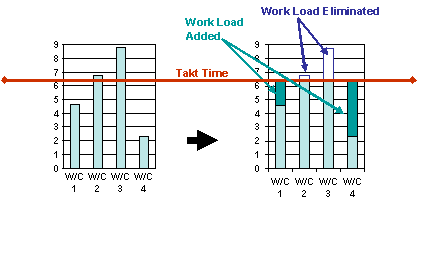
The design of a lean production line operation starts with the takt time and the question what is the customer demand rate? Ideally, all production operations are designed to be balanced according to the takt time. For manual operations, work elements are assigned to individual operators to be loaded to the takt time. Machines can be dedicated to a product family, and their cycle times can be matched to the takt time.
Takt time is the calculated time between
units of production output, synchronized to match the rate of the customer demand. Takt time is the
rhythm (repetition time or pace) of production needed to meet the customer demand.
Takt time = (Net Available Operating Minutes) / (Demand Quantity)
Example: If your demand for the products on the line is 150 pieces, and you have two shifts of 8 hours each, then:
Takt Time = ( 2 Shifts * 8 Hours * 60 Minutes) / 150 piece
= 960 minutes/ 150 pieces
= 6.4 minutes/ piece
This means a unit needs to be completed every 6 minutes and 24 seconds. Therefore every step or component needs to be completed or delivered every 6.4 minutes (or in multiples of it), and passed to the next work station. When the operation minutes of a certain work center is higher than the takt time, the work center causes to unbalance the production line and thus it will be impossible to meet the demand within the allotted time. On the other hand, if the operation time of a certain work center is lower than the takt time, it is a waste of resources.
To smooth out variations
in the process time within the production line, multiple machines and flexible labor
can be used. The figures below show how takt time is used to balance the
production line, smoothing operation times at each work center, adjusting operation
times to meet the takt time. The operation time can be adjusted by managing
resources and the work load of each work
center.
